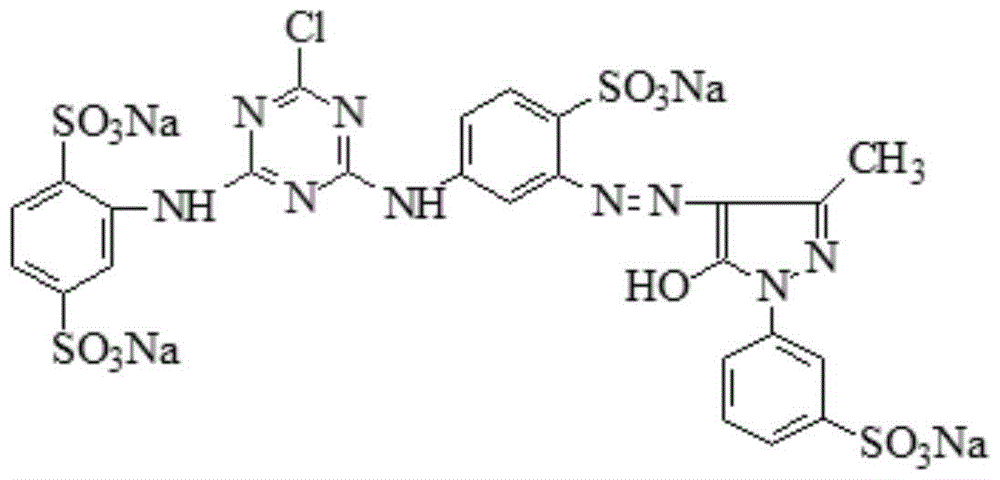A kind of synthetic method of water-based aliphatic hyperbranched polyester polymer dye
A technique of hyperbranched polyester and its synthesis method, which is applied in the fields of dyeing, organic dyes, textiles, and papermaking, and can solve the problems of polymer dye preparation and application that have not been reported, so as to improve the utilization rate of dyestuffs and improve the color fastness , the effect of easy synthesis
- Summary
- Abstract
- Description
- Claims
- Application Information
AI Technical Summary
Problems solved by technology
Method used
Image
Examples
Embodiment 1
[0034] Step 1: Add 9 g of 1,4-butanediol, 187.6 g of 2,2-dimethylol propionic acid, and 1 g of catalyst p-toluenesulfonic acid into a reactor equipped with a stirring, heating and condensing device. Nitrogen, the temperature was slowly raised to 140°C, and the reaction was carried out for 4 hours. During the reaction, the generated water was removed under reduced pressure. Cool down to room temperature after completion of the reaction to obtain an aliphatic hyperbranched polyester (hydroxyl-terminated hyperbranched polyester) whose terminal group is a hydroxyl group.
[0035] Step 2: Add 200 g of N,N-dimethylformamide and 78.4 g of maleic anhydride to the hydroxyl-terminated hyperbranched polyester prepared in Step 1, raise the temperature to 90° C., and react for 2 hours. Cool to 70 DEG C after completion of reaction, add deionized water 500g, and be that the pH of 30% sodium hydroxide aqueous solution regulation system is 10~11 with mass concentration, obtain the aliphatic h...
Embodiment 2
[0039] Step 1: Add 7.6g of propylene glycol, 187.6g of 2,2-dimethylolpropionic acid, 1.5g of catalyst p-toluenesulfonic acid into the reactor equipped with stirring, heating and condensing devices, and slowly raise the temperature to 145° C., reacted for 5 hours, and removed the generated water under reduced pressure during the reaction. Cool down to room temperature after completion of the reaction to obtain an aliphatic hyperbranched polyester (hydroxyl-terminated hyperbranched polyester) whose terminal group is a hydroxyl group.
[0040] Step 2: Add 250 g of N,N-dimethylformamide and 58.8 g of maleic anhydride to the hydroxyl-terminated hyperbranched polyester prepared in Step 1, raise the temperature to 100° C., and react for 4 hours. Cool to 70 DEG C after completion of reaction, add deionized water 600g, and be that the pH of 30% potassium hydroxide aqueous solution regulation system is 10~11 with mass concentration, obtain the carboxyl-modified aliphatic hyperbranched p...
Embodiment 3
[0044] Step 1: Add 9.2 g of glycerol, 120.6 g of 2,2-dimethylolpropionic acid, and 1.3 g of catalyst p-toluenesulfonic acid into a reactor equipped with a stirring, heating and condensing device, and feed in nitrogen, Slowly raise the temperature to 140°C and react for 6 hours. During the reaction, the generated water is removed under reduced pressure. Cool down to room temperature after completion of the reaction to obtain an aliphatic hyperbranched polyester (hydroxyl-terminated hyperbranched polyester) whose terminal group is a hydroxyl group.
[0045] Step 2: Add 210 g of N,N-dimethylformamide and 49 g of maleic anhydride to the hydroxyl-terminated hyperbranched polyester prepared in Step 1, raise the temperature to 90° C., and react for 2.5 hours. After the reaction was completed, the temperature was lowered to 65° C., 470 g of deionized water was added, and the pH of the system was adjusted to 10 to 11 with a 30% aqueous sodium hydroxide solution to obtain a carboxyl-mod...
PUM
 Login to View More
Login to View More Abstract
Description
Claims
Application Information
 Login to View More
Login to View More - R&D
- Intellectual Property
- Life Sciences
- Materials
- Tech Scout
- Unparalleled Data Quality
- Higher Quality Content
- 60% Fewer Hallucinations
Browse by: Latest US Patents, China's latest patents, Technical Efficacy Thesaurus, Application Domain, Technology Topic, Popular Technical Reports.
© 2025 PatSnap. All rights reserved.Legal|Privacy policy|Modern Slavery Act Transparency Statement|Sitemap|About US| Contact US: help@patsnap.com



